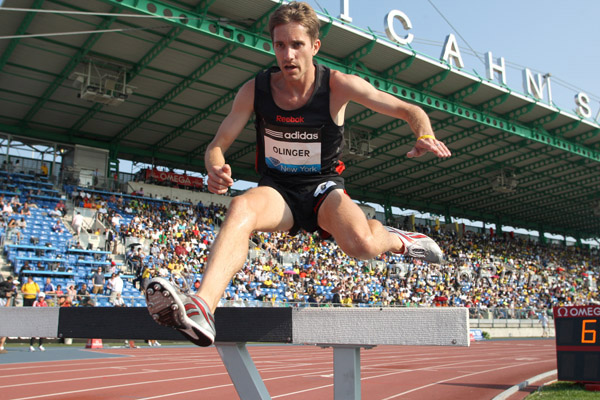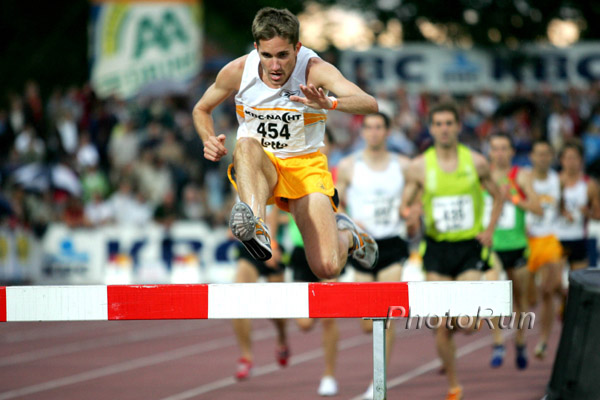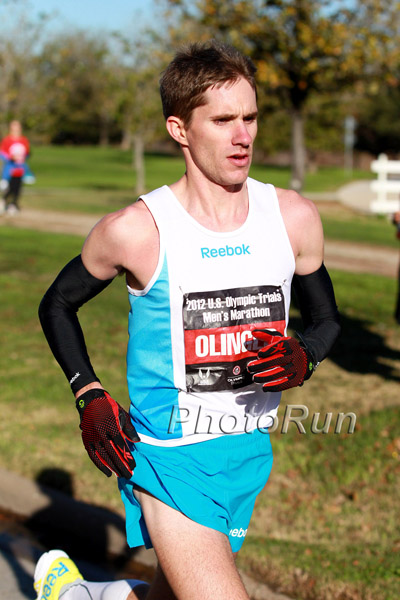 Brian Olinger, 2011 AVIVA London,
Brian Olinger, 2011 AVIVA London, photo by PhotoRun.net
Dave Hunter wrote this piece for us. One of our new writers over the past year, Mr. Hunter is a track fan, who gives us a great view of the sport, from his unique perspective. This is a fun article on Brian Olinger, who I have lucky enough to watch run for many years.
Brian Olinger: The Road Not Taken
Versatile Distance Ace Weighs Options
by Dave Hunter
RelatedPosts
 Brian Olinger, adidas GP 2010, photo by PhotoRun.net
Brian Olinger, adidas GP 2010, photo by PhotoRun.netTrack & Field, like life itself, is filled with many decisions. An
athlete displaying an undeveloped talent and an interest in the sport
will soon be confronted with an array of choices. “Do I stay with the
discus, or might I be better at the hammer?” “I’m a promising long
jumper, but might I be an even better triple jumper?” “Is the 1500 my
best event, or is it the 5000?” The imprint and the finality of the
often-subtle choices we face and make every day may never have been
better captured than by Robert Frost in “The Road Not Taken” – his
simple and graceful poem about the bittersweet consequences of the
choices we make.
One American track athlete who has an appreciation for the magnitude of
decision-making and the impact that choices have upon “our journey” is
Brian Olinger – a versatile and talented distance runner who has many
Frostian roads before him.
At age 28, Olinger is a seasoned distance runner whose career
performances display a Rod Dixon-like range of talent in a wide band of
distance events. At the Ohio State University, and under the careful
tutelage of his college coach Robert Gary, Olinger was able to transform
from a very good high school distance runner into an impressive
collegiate performer. After Olinger’s graduation, Coach Gary – a two
time Olympian in the 3000 meter steeplechase – continued to nurture
Olinger’s development. While Olinger is best known for his steeplechase
prowess – his P.R. is 8:19.56 – a deeper look at his array of
performances reveals his versatility. With a mile best that is just a
tick above 4:00 [literally 4:00.1], Olinger has excellent speed for a
longer, middle distance runner. At the Mt. SAC Relays earlier this
spring, Olinger shaved 5 seconds off his previous 5000 best with a time
of 13:26.94. The following week, Olinger joined a stacked field in the
10,000 at the Payton Jordan / Cardinal Invitational at Stanford. His
seventh-place finish in 27:50.58 was another huge 17 second PR and just
missed the Olympic “A” standard of 27:45. Had the opening 5000 – passed
by Olinger and the lead pack in a restrained 13:55 – been just a little
more ambitious, an “A” standard mark might have been in the cards for
Olinger.
 Brian Olinger, Heusden 2007, photo by PhotoRun.net
Brian Olinger, Heusden 2007, photo by PhotoRun.net While some might see Olinger’s recent performances as nothing but
positive, it did create a special quandary for this versatile athlete:
What is the game plan for Eugene? Steeplechase or 10,000? In
mid-April, at the Jesse Owens Classic, Brian noted: “What we don’t want
to do is to go the Trails and say, ‘Well, let’s run this and if this
doesn’t work, let’s do this.’ We want to have a concrete plan. A lot
will depend if I can get the “A” standard [27:45] at Payton Jordan in
the 10. So if you get that, the 10K decision becomes harder. Because I
think you are a viable competitor. I think there is a spot out there in
the 10. If a runner has shown 27:30 fitness, then a person like that is
a threat.” That may be especially true at the Trials where the 10,000
is likely to be somewhat tactical.
And as the days leading up to the USA Track & Field Trials continued
to slip away, Olinger, like so many others, ultimately had to make a
decision about which event – the steeplechase or the 10,000 – he would
run in Eugene in his quest to capture a coveted spot on the Olympic
team. “It is full steam ahead with the steeple,” said Olinger in an
interview earlier this week. “During the past ten days, I have had 3 of
the best hurdling sessions of my career.” Olinger will head off to the
west coast this weekend to compete in his first 3000 meter steeplechase
of year at the USATF Oxy High Performance Meet at Occidental College.
“If the competition is there, I am hoping to run under the “A” standard
[8:23.1].”
But even after his Eugene event selection has now been made and even
after this upcoming Olympiad is over, there is yet another event – the
cruelest of mistresses – that beckons his name…the marathon.
It is undeniable that Olinger has made his mark on the track. But
Olinger’s upper range of versatility may not stop with 25-lappers. As
this year began, using the USA’s expanded qualifying standards, Olinger
parlayed an earlier 10,000 qualifying time of 28:07.52 to gain entry
into the USA Olympic Marathon Trials in Houston this past January – even
though he had never run a marathon and had never raced farther than 7
miles [First American finisher in Falmouth in 2011]. What? How does
that happen? How does it make sense for a 3000 meter steeplechase guy
to all of sudden hop into the Olympic Marathon Trials? “I must admit
that it was a vocabulary word [“marathon”] that we [Coach Gary and I]
had never exchanged back and forth in ten years of working together,”
notes Olinger. “But the timing was such that it made sense.”
Olinger’s unorthodox qualifying credentials for Houston’s Trials race
made him a center of media attention and, to the uninformed, prompted
speculation about his fitness to compete with the country’s best
marathoners. But Olinger prepared diligently for the Trials with a
steady diet of 100+ mile weeks featuring high-quality long weekend runs
of 20+ miles. “With Coach Gary on the bike, it would be 5:40 pace right
out the door. After about 6 miles, we’d drop it down to 5:00 pace for
about 13 miles before we cooled it down to the end.” And in January
pre-race interviews, Olinger made it clear that he was in Houston not
merely to compete in the Trials, but to make the team: “I wouldn’t be
here if I didn’t think I had a legitimate shot to finish in the top
three.” He backed up his words with race day action as he was one of a
small pack of runners bold enough to respond to Ryan Hall’s opening gun
salvo of 4:50 miles. And while his back door departure from the lead
pack at around the 10 mile mark was hasty – and ultimately led to a DNF –
his spirited and gutsy performance at the Trials prompted many to view
Olinger’s Trials experiment not as ill-conceived, but as courageous. It
has even caused some to speculate that Olinger – with his proven leg
speed, with the right training for an extended period, and with more
experience – may be able to cultivate a most successful future for
himself in the longer event. Olinger, too, has allowed himself to think
about it: “It [the marathon] intrigues me. It is something I want to
do again. And I want to put forth an honest effort. I like the
training. It is right in my wheelhouse. I am more of a road guy than a
track guy.”
 Brian Olinger, 2012 US Olympic Trials-Marathon, photo by PhotoRun.net
Brian Olinger, 2012 US Olympic Trials-Marathon, photo by PhotoRun.net With his Olympic Trials choice, Brian Olinger has faced – and made – a
critical decision about his track & field journey. He gauged his
training, he ran in some high quality races, and he made a difficult
choice: if he is to represent the United States in the London Olympics,
it will be in the steeplechase. But Brian knows that pivotal decisions
about his future path in track & field remain. One of many would
be: how, if at all, does the marathon fit into his future? We can be
sure that Brian Olinger, a measured and thoughtful young man, will make
this and other key decisions with care and only after great thought.
But, even then, no one will ever know – not even Brian – if he made the
right choices. But those choices, to paraphrase Robert Frost, will make
all the difference.
Dave Hunter
Author

Larry Eder has had a 52-year involvement in the sport of athletics. Larry has experienced the sport as an athlete, coach, magazine publisher, and now, journalist and blogger. His first article, on Don Bowden, America's first sub-4 minute miler, was published in RW in 1983. Larry has published several magazines on athletics, from American Athletics to the U.S. version of Spikes magazine. He currently manages the content and marketing development of the RunningNetwork, The Shoe Addicts, and RunBlogRun. Of RunBlogRun, his daily pilgrimage with the sport, Larry says: "I have to admit, I love traveling to far away meets, writing about the sport I love, and the athletes I respect, for my readers at runblogrun.com, the most of anything I have ever done, except, maybe running itself." Also does some updates for BBC Sports at key events, which he truly enjoys. Theme song: Greg Allman, " I'm no Angel."
View all posts




















